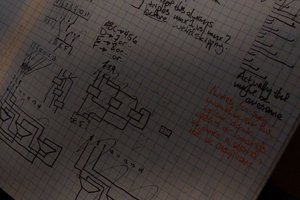The overall technical details for this project aren't all that complex, ground breaking, or even exciting.
I think the interesting thing about this project is that it's the result of a whole lot of procrastination, a significant amount of being lazy, and a single Aha! moment.
Oh, and at the end of the description, I'll explain what I mean by Imposter Syndrome Version.
Here is the story:
It's the end of 2010 when I happen upon this:
https://www.instructables.com/Spinner-Jog-Wheel-Inside-of-a-VCR-Head/
I immediately went to the thrift store, purchased a dusty old VCR, took it home, and promptly took it apart. I was feeling super inspired! Oh, and VCR heads are very therapeutic to spin (which was a concept that was only a few years ahead of its time).
Shortly after that initial burst of inspiration, the lazy kicked in. I wasn't going to separate the brains of the mouse from its current PCBA just to mount it on another board so it would fit in the VCR head. No way! Why not just hide the original PCBA in the base of the awesome stand/case I was going to build, and just route some wires up to the relocated IR emitter and receiver in the VCR head? Then I would just figure out some easy/simple way to pass something between the emitter and receiver. You know, exactly the same way they do on most mouse wheels anyway. But different.
So many mice were taken apart.
So many terrible attempts at unblocking/blocking the path between the IR emitter and receiver while spinning the VCR head were made.
Well, there was this cool 3D printed gear-flared-finger thing that a coworker made for me that wasn't terrible. Remember back then 3D printers weren't so ubiquitous. It was a very nicely designed/printed part, gosh darn it, and at the time still such a novel thing to have fabricated. But despite the awesomeness of that printed part, I was still not making progress.
Frustration set in, and time started to march on without me.
Every now and then I would pick up my VCR head spinner project and give it another try, but to no avail.
Sigh.
Fast forward to late 2022. I was at work editing what must have been a zillion page document, as one often does. I noticed that I was feverishly switching between the mouse wheel and the scroll bar on the right side of the editor window and the page up/down buttons and the arrow keys. Suddenly, I was wishing for that VCR scroll wheel thing, and just feeling silly on every level. What the heck? All these years had passed and I hadn't managed to get much farther than busting apart that VCR.
And then I remembered the magnetic rotary encoder demo board from a few years back that I had picked while evaluating parts for another project at work!
NOTE: This is not the same place at which I was working when the 3D part was printed. And it's not the place at which I am working now. It was another place. Where I was working previously and presently and in-between might not matter in the grand scheme of things, but the timeline of this project is now more than a decade long. These details add context, or something.
And then I remembered that microcontrollers can easily emulate computer peripherals!
I fell down the mechanical keyboard rabbit hole a several years ago. As the falling continued, I had been noticing a lot of mechanical keyboard projects utilizing the Raspberry Pico. While I hadn't gotten around to picking up any of those little guys to try out, I did have the typical stash of other microcontrollers collecting dust. Um, I mean, sitting idle. Well, it turns out that they can easily do peripheral emulation too!
Anyway, it didn't take too long to locate the rotary encoder demo board. Okay, maybe it took hours, but it didn't take days or weeks or years. I couldn't find the magnet, but that didn't take too long to find online, order, and receive.
There wasn't actually that much dust on the the microcontroller pile. On the top of the pile was a Teensy2.0....
Read more » crispernaki
crispernaki





 Kal
Kal
 BART
BART
 Eric Moyer
Eric Moyer
 Arya
Arya
@Elliot Williams I think it's pretty cool that you have to spin up your spinner before it starts to spin.
Thanks for the kind words